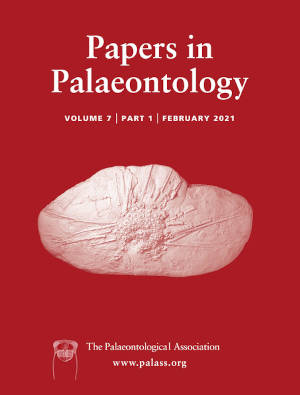Reg. Charity No. 1168330

Trilobites offer almost unparalleled insight into the growth and development of fossil ecdysozoans. Here I use newly collected material of Elrathia kingii (Meek) to estimate growth rates and describe shape change over the ontogeny of E. kingii. Well-preserved, articulated specimens from all post-embryonic stages were collected from a 1.5 m interval of the upper Wheeler Formation (Miaolingian Series, Cambrian) in western Utah (USA), and size and landmark-based shape data were digitized from photographs. Growth rates were estimated and compared with previously published data on the Silurian trilobite, Aulacopleura koninckii (Barrande). Like A. koninckii, the cephalic growth rate in E. kingii was constant and of similar magnitude to the minimum growth rate along the trunk, and growth rates in the trunk were lower during the holaspid (‘adult’) period than during the meraspid (‘juvenile’) period. However, body length at the onset of meraspis was smaller, the growth gradient along the trunk during meraspis was shallower, and the terminal number of thoracic tergites was smaller in E. kingii than in A. koninckii. Despite these differences, these two species had similar maximum body lengths, because higher overall growth rates in E. kingii compensated for other differences. The rate of cephalic shape change in E. kingii decreased at the transition from meraspis to holaspis, while the pygidium became more morphologically distinct from the thorax during holaspis. I also provide an emended diagnosis for E. kingii, descriptions of the ontogeny and ventral morphology, and evidence that E. kingii holaspids had an invariant number of tergites.
AcknowledgementsThank you to Markus Martin, Mariah Slovacek, and Jacob Spicer for assistance in the field; to Mariah Slovacek and Anastasia Rashkova for fossil preparation; to Esteban López Murillo for assistance with data collection; to Nigel Hughes for discussion; to Carolyn Levitt-Bussian (UMNH), Quintin Sahratian (University of Utah), and Dick Robison (Kansas University) for their efforts in trying to locate Robert Bright's Elrathia collection; to Mark Florence (Smithsonian NMNH) for answering questions about the type specimens; to Lukáš Laibl, Sally Thomas, and an anonymous reviewer for helpful comments that improved the manuscript; and to Greg McDonald and Todd Leeds at the Bureau of Land Management in Utah for facilitating collection permits. Specimens were collected in May 2018 under permit UT18-005S.